|
| Captain's Pin |

|
| 1916-1923 |
iImage
donated by Terry Beye
|
| Leiutenant's Pin |
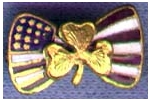
|
| 1917-1922 |
Image donated by the Altvaters
Since Girl Scout leaders (Captains) earned
badges and wore the same uniform (with badges and ranks sewn on just like the girls) something had to be done to identify
the leaders. Special hat and shoulder cords were worn, and around 1916 the Capitan's Pin was introduced.
The gold 3-leaf clover sits atop a red, white and blue shield. In 1917 a Lieutenant's Pin was introduced,
to be worn until the adult passed the First Class Rank - when it was switched to the Capitan's Pin. The Lieutenant's Pin was
discontinued in 1922.
Location
|
| example of EARLY Service Pins |
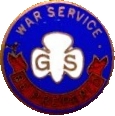
|
| Image donated by the Altvaters |
There are 3 versions of the early Service Pins;
WAR SERVICE - shown
COMMUNITY SERVICE - light green and dark green
Check out the War Service and
Special Awards page for more detailed information on these pins.
|
|
The Traditional Logo Girl Scout pin was
once called the Tenderfoot Pin. The symbolic design of the pin, according to The Girl Scout Collector's Guide, is as follows:"the
eagle is a symbol of strength and victory and the shield on the eagle's breast signifies self-reliance. In his talons, he
clutches on his right an oliver branch, the symbol of peace and on his left a shaft of arrows, the symbol of might. The eagle
faces right, which is the position of honor, looking toward the symbol of peace. The eagle and shield within the trefoil signify
that Girl Scouts stand ready to serve their country." The shape of the pin, a trefoil, indicates the threefold promise.
|
| 3 Stars on Shield - No "GS" |
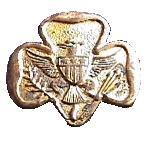
|
| pre-1918 |
| 3 Star 3 Stripes on Shield |
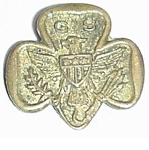
|
| 1918-1920 |
Location
|
| 3 Star 4 Stripes On Shield |
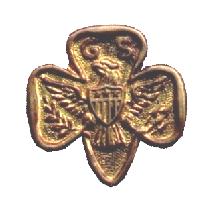
|
| 1920-1923 |
|
|
| Image donated by Cheryl McGruff |

|
| 1926 "W" Tenderfoot Pin |
|
| Close up of Cheryl's Pin |

|
| Close-up of 1926 "W" Tenderfoot Pin |
|
According to the Girl Scout Collector's Guide, during the International Conference held at
Macy's, this "W" pin was given out to participants. The "W" is for world.
The close-up shows that the "W" wasn't simply stamped on the shield, but that the shield isn't
even there.
|
|
| 7 Star Membership |

|
| 1923-1934 |
The 7 Star pin in the standard size is rare, due to the short time it was offered. However, the miniature
version was offered for a long time and is not rare.
|
| Citizen/Senior Girl Scout Pin 1921-1929 |
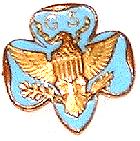
|
| Image donated by Gail C. Schrader |
Citizen Scouts - older Girl
Scouts, were committed to community service, fulfilling the 8 hour a month requirement of service. The uniform of the Citizen
Scout at first, was a khaki armband, with troop crest and red ribbon. Later various uniform changes were offered. Girls could
continue to earn badges, and wear badges earned previously. The blue enameled pin was introduced in 1921 to match with the
blue serge of the current uniform. It was replaced by the green enameled pin in 1929.
|
| Senior Girl Scout Pin 1929-1938 |
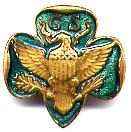
|
| Image donated by Talli |
This pin was first offered in 1929 for Senior Girl Scouts,
replacing the blue enameled pin. It was enameled green to better match the uniform.
|
|
| World War II Era - "thin pin" issue |
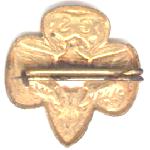
|
| Image donated by Becky McCray |
|
| World War II Era "thin pin" Front |
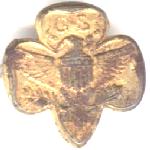
|
| Image donated by Becky McCray |
|
World War II called for conservation of almost all
materials - paper, metal, sugar. etc. Girl Scouting rose to the need in many ways. One such way was to have the membership
pin produced on thinner metal - leaving the backside with the reverse impression of the pin. This is not to be confused with
later productions of the pin. My understanding from Girl Scout folklorists and collectors is that if a magnet attaches to
the pin - it's a WWII issue, if not it's a later production. Girl Scouting also had the Mariner pin changed to a flat rayon
badge style briefly. No known examples have been found - yet!
|
|
| WAGGGS 1949-1990 |

|
WAGGGS and Thinking Day pins
|
| WAGGGS Friendship 1956-1976 |
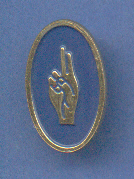
|
| Brownie Girl Scouts |
|
| 1990- current |
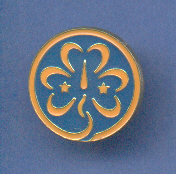
|
|
|
| Committee/Associate Pin |
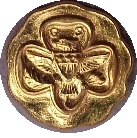
|
| 1920-1957 |
|
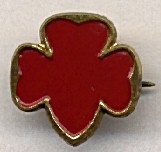
Service Bureau Pin
1941 - 1945
More info on the
War Service Pins page
|
| Senior Membership Pin |
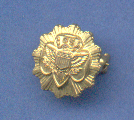
|
| 1938-1963 |
More info on the
Official Girl Level Pins page
|
|

Now being reproduced for wear on Adult Uniform wear
See the Mariner Pins page
for detailed information
on pin variations
And
Click on the patch
to jump to the
Mariner Girl Scout information page.

|
Click on the Wing Patch
to jump to the
Wing Girl Scout Information
page.

| Senior Girl Scout Wings |
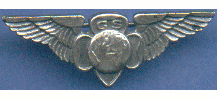
|
| 1947-1979 |
|
| Senior 5 Point Pin |

|
| 1955-1963 |
More info on the
Official Girl Level page
|
|
| First Class Girl Scout Pins |

|
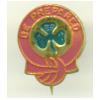
|
| Variation: smaller wording on pin |
This pin is now being officially reproduced
for wear on adult uniforms.
Check out the
Official Girl Level page
for more information.
|
| Intermediate GS Curved Bar Award |

|
| 1947-1963 |
This pin is now officially
being reproduced
for adult uniformed wear.
Check out the
Official Girl Level page
for more information.
|
| First Design of the Brownie Membership Pin |
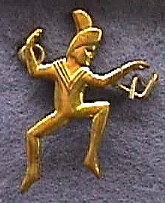
|
| 1921-1937 |
Image donated by the Altvaters
|
|
| Brownie 1937-1939 |
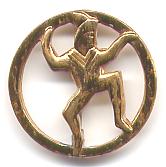
|
| Image donated by Talli |
|
| World War II metal saving Brownie pin |
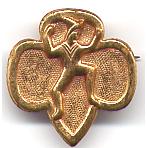
|
| Image donated by Talli |

Part of the Girl Scouts answer to the metal shortage of World War
II was to change the production of the Brownie membership pin temporarily. Using a solid piece of metal, the pin could be
made thinner, thus saving metal for the war effort. Punching holes in the metal for the petals was not "official" - they were
supposed to be sewn on the uniform. Original cost - 10 cents.
|
| Older Brownie Pin with membership petals |
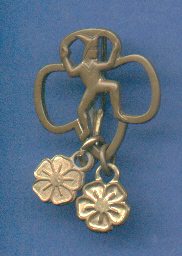
|
Membership Petals were used by Brownies, just as the green disc
and star pin are used today - to signify membership in the organization. Brownies first had a bronze star,
but swtiched to the five petal flower pendant in 1939. They switched to the star pin in 1956.
|
|
| Current Brownie Pin |

|
|
| Daisy Membership Pin 1984-1993 |
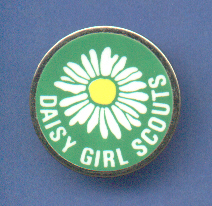
|
The Daisy Girl Scout program officially began in 1984
after many years of studying pilot programs in several councils. Designed especially for 5 years old girls in kintergarden,
it is now expanded to include 6 years old girls. Enameled design on goldtone metal.
|
| Daisy Membership Pin 1993-current |

|
This redesigned membership pin retains a vague trefoil outline with the stylistic daisy design in the center. Presented in
the fall of 1993, it is still in use.
|
| Older Traditional Membership Pin |
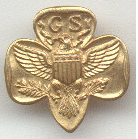
|
|
| Newer Traditional Membership Pin |
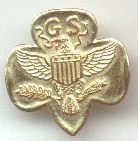
|
|
There have no official changes in the traditional membership
pin since 1934 with 4 stars on the shield. However small changes have been noticed.
Older pin: 11 outer feathers, large group of arrows
Newer pin: 9 outer feathers, smaller group of arrows
|
|
Pin 1: smooth, faces somewhat defined
|
Pin 2: raised edges, faces clearly defined
|
Pin 3: Lettering style different, faces not defined
|